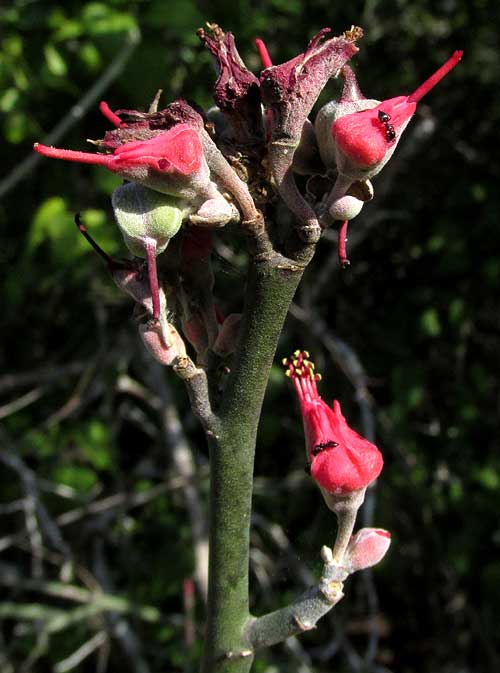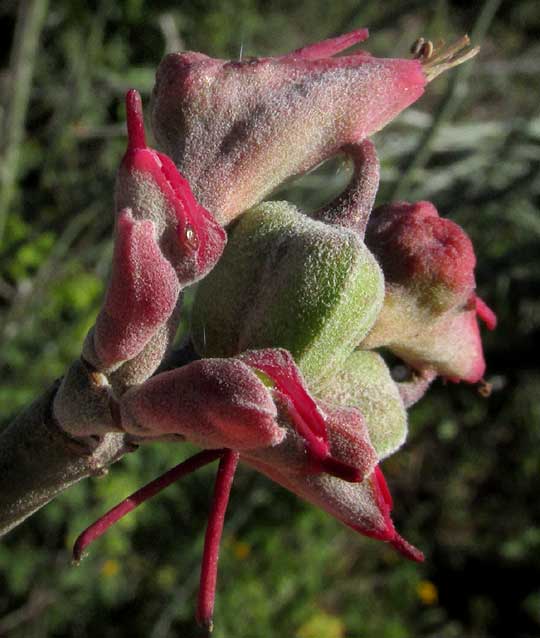Excerpts from Jim Conrad's
Naturalist Newsletter
from the November 23, 2014 Newsletter issued from Río Lagartos, on the Yucatan Peninsula's northern coast (~N21.60°, ~W88.16°), Yucatán state, MÉXICO
SLIPPER SPURGE
In those occasional spots where very thin soil lies atop limestone and the forest has been cleared or maybe never got established in such thin soil, around here you're likely to find a head-high shrub with many slender, succulent, mostly leafless stems of a kind you expect in deserts, not areas like ours mainly occupied with broadleaf shrubs and low trees. Below, you can see my photographer friend Jim Legault providing scale next to one:

Nowadays at the tips of those leathery, white-latex filled stems you find clusters of very distinctive flowering structures, each shaped something like an apple turnover. Each structure is equipped with two blackish, eye-like glands exuding an ant-attracting substance, some ants nearly always found supping there, as shown below:

A close-up of a flowering structure is shown below:

Notice that the turnover-looking structure at the top of the picture has some pale items emerging from it directed toward the picture's top, right corner. Those are pollen-releasing anthers. The greenish, egg-shaped item in the picture's center, dangling on a maroon-colored stem emerging from the turnover's bottom, is an ovary. Two long, slender, red styles point downward from the ovary.
In other words, what we've been calling a turnover is actually a "cyathium," inside which reside a cluster of close-packed male flowers, each consisting of a single stamen. The ovary dangling on its maroon stem is the female flower. All this strange floral anatomy constitutes the classic basic configuration of that large group of flowering plants known as the spurges, genus Euphorbia, in the Spurge or Poinsettia Family, the Euphorbiaceae. We've profiled numerous euphorbias in this Newsletter, but this is the first species in which the cyathium was shaped like an apple turnover.
The big genus Euphorbia embraces about 2000 species and it's hard to think of a genus with more variability in its appearance -- from leafy trees to low, spiny, cactus-like forms -- but they all produce their much-reduced flowers in cyathia. However, only a small number of euphorbias produce cyathia shaped like apple turnovers. For many years those with such cyathia were set aside in the genus Pedilanthus, but now genetic sequencing reveals that really they're just normal euphorbias with a novel adaptation. Apparently to their hummingbird pollinators the reddish cyathia are shaped not like apple turnovers but hummingbird heads, with the black, ant-attracting glands looking like hummingbird eyes.
Our Río Lagartos plants are EUPHORBIA PERSONATA. Really there's no common English name for them, but another better-known species with similarly shaped cyathia is known as a Slipper Spurge, so this one might as well share that name. Our Río Lagartos species is distributed from here in the Yucatán south to Costa Rica. However, it inhabits only clearings on limestone outcrops, mostly near the coast, so its occurrence is very spotty and limited. Here it's commonly encountered, but during my two years in the Chichén Itzá area about an hour south and inland from here I never saw it.
When I first saw how common the plant is here, I thought it might be a weed, but now it's clear that it's yet another unusual species the Ría Lagartos Biosphere Reserve can be proud to be home to.